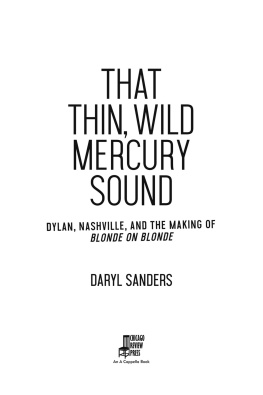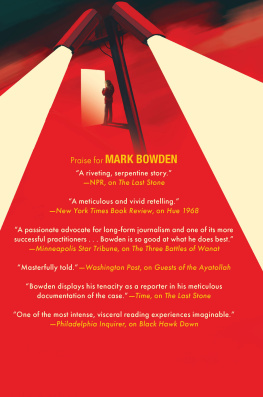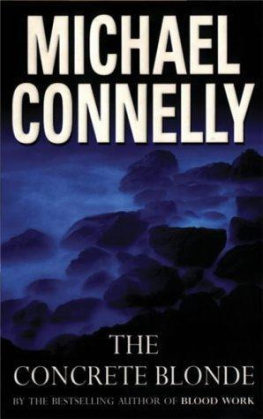Names: Sanders, Daryl, author.
Title: That thin, wild Mercury sound : Dylan, Nashville, and the making of
Blonde on blonde / Daryl Sanders.
Description: First edition. | Chicago, Illinois : Chicago Review Press,
[2018] | Includes bibliographical references.
Identifiers: LCCN 2018021680 (print) | LCCN 2018022916 (ebook) | ISBN
9781613735480 (Pdf) | ISBN 9781613735497 (Mobipocket) | ISBN
9781613735503 (Epub) | ISBN 9781613735473 (cloth)
Subjects: LCSH: Dylan, Bob, 1941-. Blonde on blonde.
Classification: LCC ML420.D98 (ebook) | LCC ML420.D98 S2 2018 (print) |
DDC 782.42164092dc23
LC record available at https://lccn.loc.gov/2018021680
PROLOGUE
WHEN BOB DYLAN ARRIVED at Columbia Records Nashville studios on Valentines Day in 1966 to continue work on the follow-up to Highway 61 Revisited, he was a man on a mission, a musical mission, searching for a particular sound he could hear in his head, a sound he would describe twelve years later as that thin, that wild mercury soundmetallic and bright gold.
Dylan had begun his search for that thin, wild mercury sound thirteen months and two albums earlier in the labels New York studios, with his initial forays being released on Bringing It All Back Home, the first of the trilogy of albums on which he famously went electric. While only side one of that record actually included accompaniment by musicians using amplified instruments, it obviously was the side that inspired the albums title, for he truly was bringing it back homeback to the music of his youth, the music that first inspired him to write songs and take up an instrument.
Dylan was reaching back into that Bermuda triangle of rock and rollblues, country, and R&Bwhere so many teens like himself got lost; back to a thrilling era when music that could indeed be described as metallic and bright gold challenged the status quo and broke down cultural barriers.
Dylan was aiming to break down some barriers of his own. The particular sonic quicksilver he was hearing in his head, a blend of guitar, keyboards, and harmonica, emerged more fully on his next album, Highway 61 Revisited, beginning with guitarist Al Kooper crashing the first session only to find Michael Bloomfield there. Although only twenty-two, Bloomfield had already made a name for himself as a blues guitarist of note. Undeterred and demonstrating the boldness that would lead him to become a prominent figure in the history of popular music, Kooper put away his guitar, slid behind the studios Hammond B-3 organ, an instrument he had never before played, and delivered the signature organ riff for Like a Rolling Stone. It was one of those lightning-in-a-bottle moments when something that wasnt planned led to an artistic breakthrough; in Dylans case, the result was a recording that singlehandedly elevated popular music as an art form.
Although the rest of the album didnt quite match the artistic heights reached on Like a Rolling Stone, some critics and music scholars consider Highway 61 Revisited Dylans greatest achievement. The title is a reference to US Highway 61, which before the advent of the interstate highway system was the primary roadway connecting Dylans home state of Minnesota to the South. Sometimes called the Blues Highway, Highway 61 generally follows the path of the Mississippi River, running through St. Louis, Memphis, and the Mississippi Delta before ending in New Orleans, a total of fourteen hundred miles from its beginning in Wyoming, Minnesota.
In many ways, Dylans musical compass had always been pointing south. The radio stations in his hometown of Hibbing, Minnesota, and other towns nearby, only played the pop fare of the day; but that was in the heyday of AM radio, when after the sun went down, fifty-thousand-watt clear-channel radio stations dominated the airwaves. Late at night in his bedroom, often with his radio under the covers so the music wouldnt wake anyone, Dylan would search the dial for the broadcast behemoths south of the Mason-Dixon line that were pumping blues, country, R&B, and early rock and roll into the nighttime air.
It set me free, set the whole world on fire, he recalled in the liner notes to the box set Biograph.
Two of the clear channel stations Dylan listened to regularly were broadcasting out of Nashville: WSM and WLAC. Those stations represented his earliest introduction to the city, nightly reminders that Nashville was a source for the new and exciting sounds that were enlivening his mostly uneventful life in Hibbing.
WSM was where he discovered his first musical idol, Hank Williams. The first time I heard Hank he was singing on the Grand Ole Opry, a Saturday night radio show broadcast out of Nashville, Dylan wrote in his 2004 memoir. The sound of his voice went through me like an electric rod.








